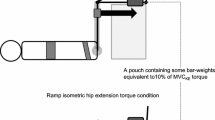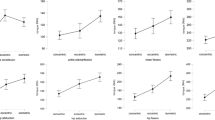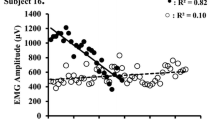Abstract
Surface integrated electromyograms (iEMG) of agonist and antagonist muscles were studied during the rising phase of maximal isometric efforts (elbow flexion, unilateral and bilateral leg extension) to explain the difference in maximal rate of force development (MRFD) with a hard-and-fast instruction (instruction I) and a fast instruction (instruction II ). Force and EMG were simultaneously recorded in 24 athletes and iEMG were computed at MRFD and during different phases of force development (P 0–25, P 25–50, P 50–75, P 75–90 and P 90–100). A two-way ANOVA for repeated measures (muscle × instruction) showed that the value of iEMG at MRFD was significantly higher with instruction II for elbow flexion, unilateral and bilateral leg press exercises (F>4.9; P<0.04). The effect of instruction upon iEMG of the agonist muscles corresponding to the different phases of the force development was significant for elbow flexion (F=4.2; P<0.05 ) unilateral (F>6.4; P<0.02) and bilateral leg extension (F>9 and P<0.006 for soleus and vastus lateralis; but F=3.2 and P=0.08 for vastus medialis). There was a significant interaction between instruction and phase of force development (F>2.6; P<0.05 ): iEMG was significantly higher with instruction II at the beginning of force development (P 0–25) for all the muscles (except the soleus muscle during the bilateral leg exercise) but not at higher force (P 75–90 and P 90–100). The steeper force development with instruction II can be explained by the better activation of the agonist muscles at the beginning of force development. A lower co-activation of the antagonist muscles does not explain the improvement in MRFD as the iEMG of the antagonist muscles was not lower with instruction II but was proportional to the activation level of the agonist muscle.




Similar content being viewed by others
References
Adrian ED, Bronk DW (1929) The discharge of impulses in motor nerve fibres. II. The frequency of discharge in reflex and voluntary contractions. J Physiol (Lond) 67:119–151
Bemben MG, Clasey JL, Massey BH (1990) The effect of the rate of muscle contraction on the force-time curve parameters of male and female subjects. Res Q Exerc Sport 61:96–99
Carolan B, Cafarelli E (1992) Adaptations in coactivation after isometric resistance training. J Appl Physiol 73:911–917
Christ CB, Boileau RA, Slaugher MH, Stilman RJ, Cameron JA (1993) The effect of test protocol instruction on the measurement of muscle function in adult women. J Orthop Sports Phys Ther 18:502–510
DeLuca CJ, LeFever RS, McCue MP, Xenakis AP (1982) Behavior of human motor units in different muscles during linearly varying contractions. J Physiol (Lond) 329:113–128
Grimby L, Hannerz J, Borg J, Hedman B (1981) Firing properties of single human motor units on maintained maximal voluntary effort. In: Human muscle fatigue: physiological mechanisms. Ciba Foundation Symposium 82. Pitman, London, pp 157–165
Häkkinen K, Komi PV, Alén M (1985) Effect of explosive type strength training on isometric force-and relaxation-time, electromyographic and muscle fiber characteristics of leg extensor muscles. Acta Physiol Scand 125:587–600
Koryak Y (1998) Effect of 120 days of bed-rest with and without countermeasures on the mechanical properties of the triceps surae muscle in young women. Eur J Appl Physiol 78:128–135
Kots I (1986) Sport physiology (in Russian). Fiscultura i sport, Moscow
Kukulka CG, Clamann HP (1981) Comparison of the recruitment and discharge properties of motor units in human brachial biceps and adductor pollicis during isometric contractions. Brain Res 219:45–55
Marsden CD, Meadows JC, Merton PA (1971) Isolated single motor units in human muscle and their rate of discharge during maximal voluntary effort. J Physiol (Lond) 217:12P–13P
Sahaly R, Vandewalle H, Driss T, Monod H (2001) Maximal voluntary force and rate of force development in humans—importance of instruction. Eur J Appl Physiol 85:345–350
Tanji J, Kato M (1972) Discharge of single motor units at voluntary contraction of abductor digiti minimi muscle in man. Brain Res 45:590–593
Author information
Authors and Affiliations
Corresponding author
Rights and permissions
About this article
Cite this article
Sahaly, R., Vandewalle, H., Driss, T. et al. Surface electromyograms of agonist and antagonist muscles during force development of maximal isometric exercises—effects of instruction. Eur J Appl Physiol 89, 79–84 (2003). https://doi.org/10.1007/s00421-002-0762-6
Accepted:
Published:
Issue Date:
DOI: https://doi.org/10.1007/s00421-002-0762-6




